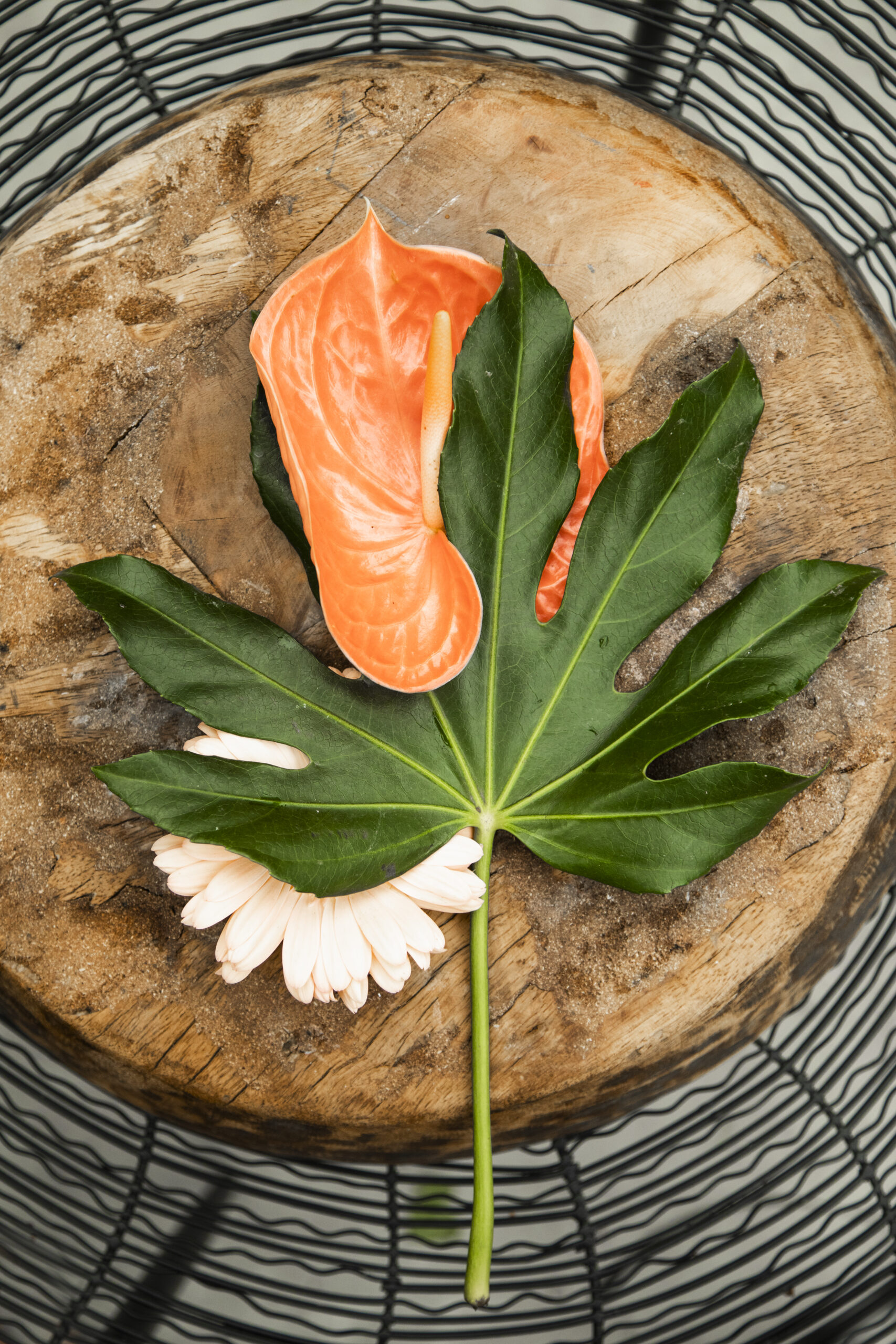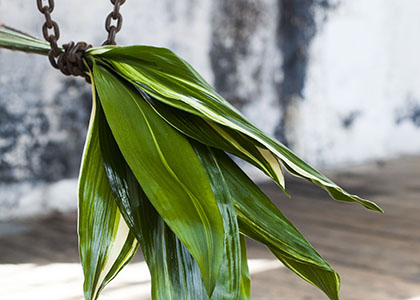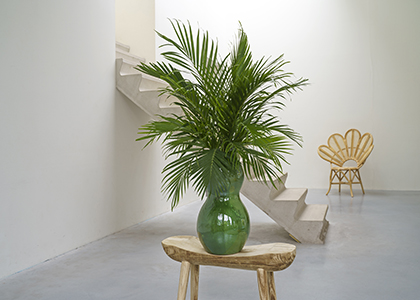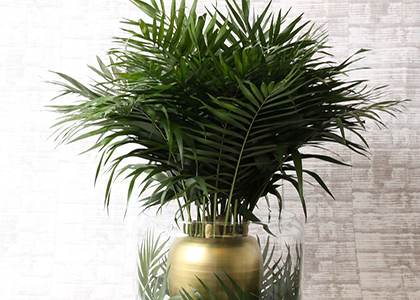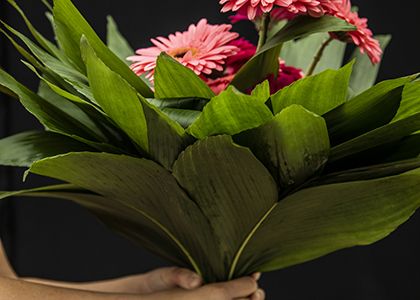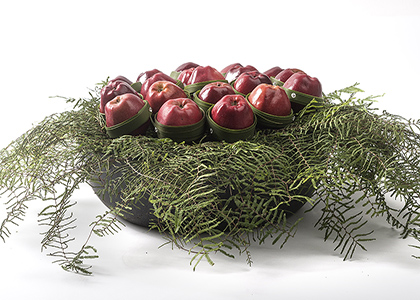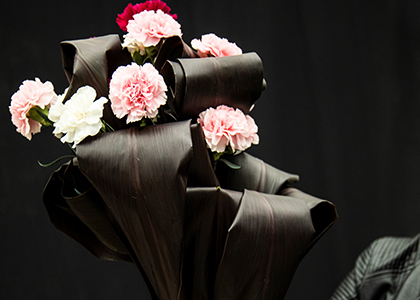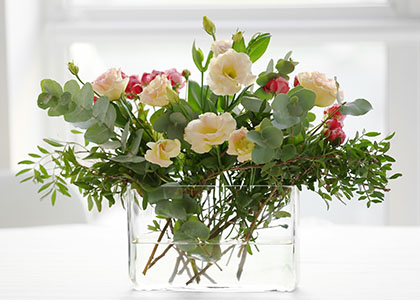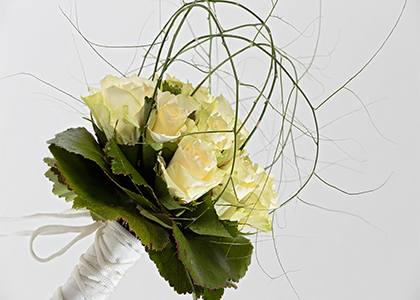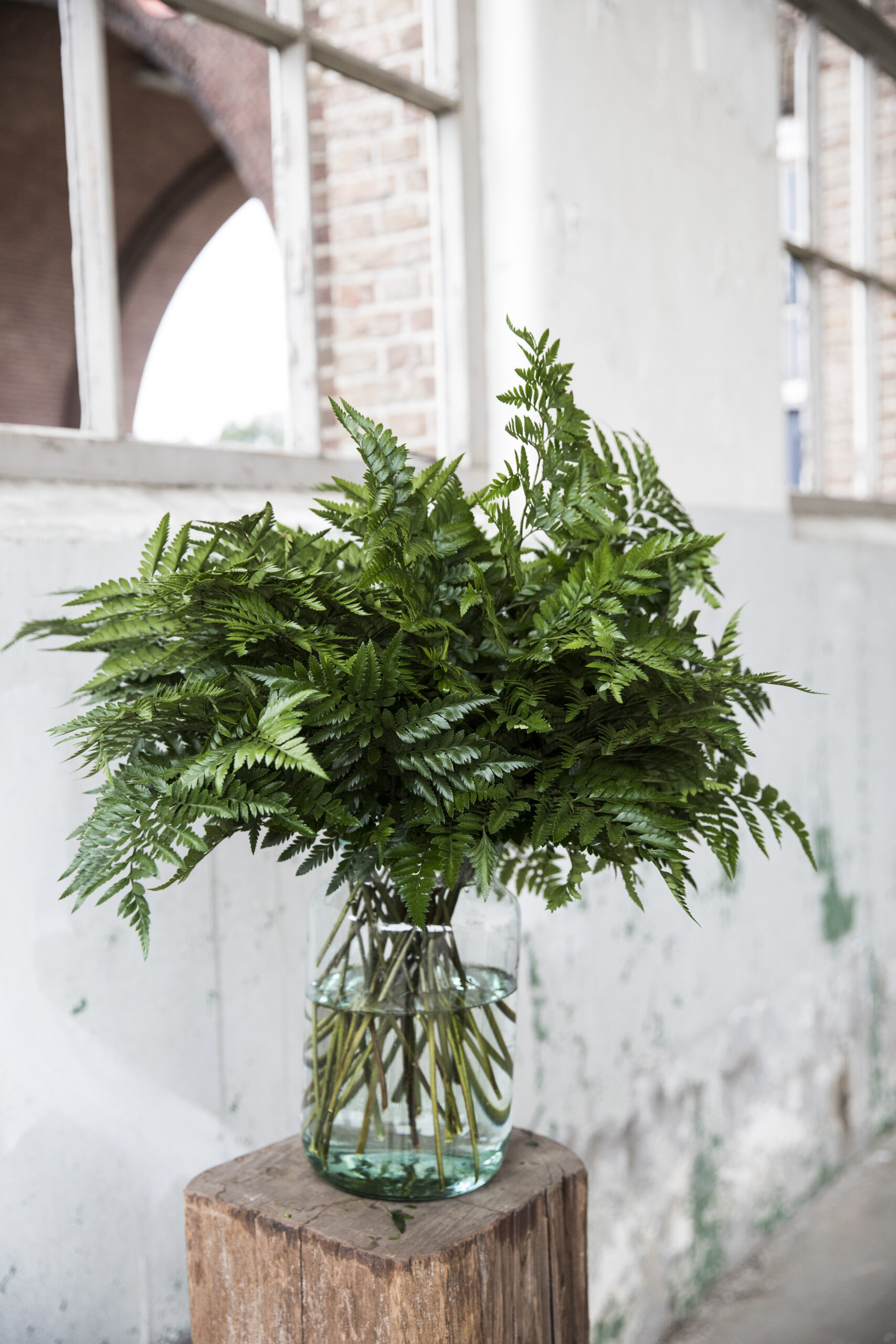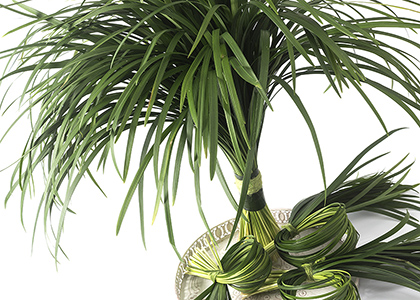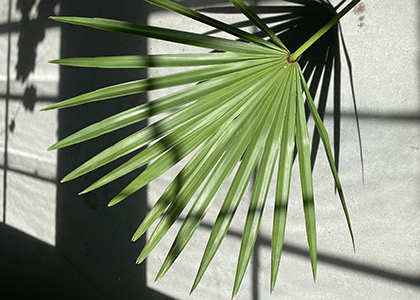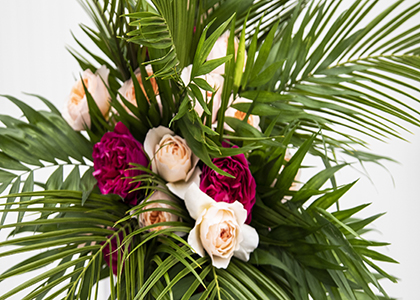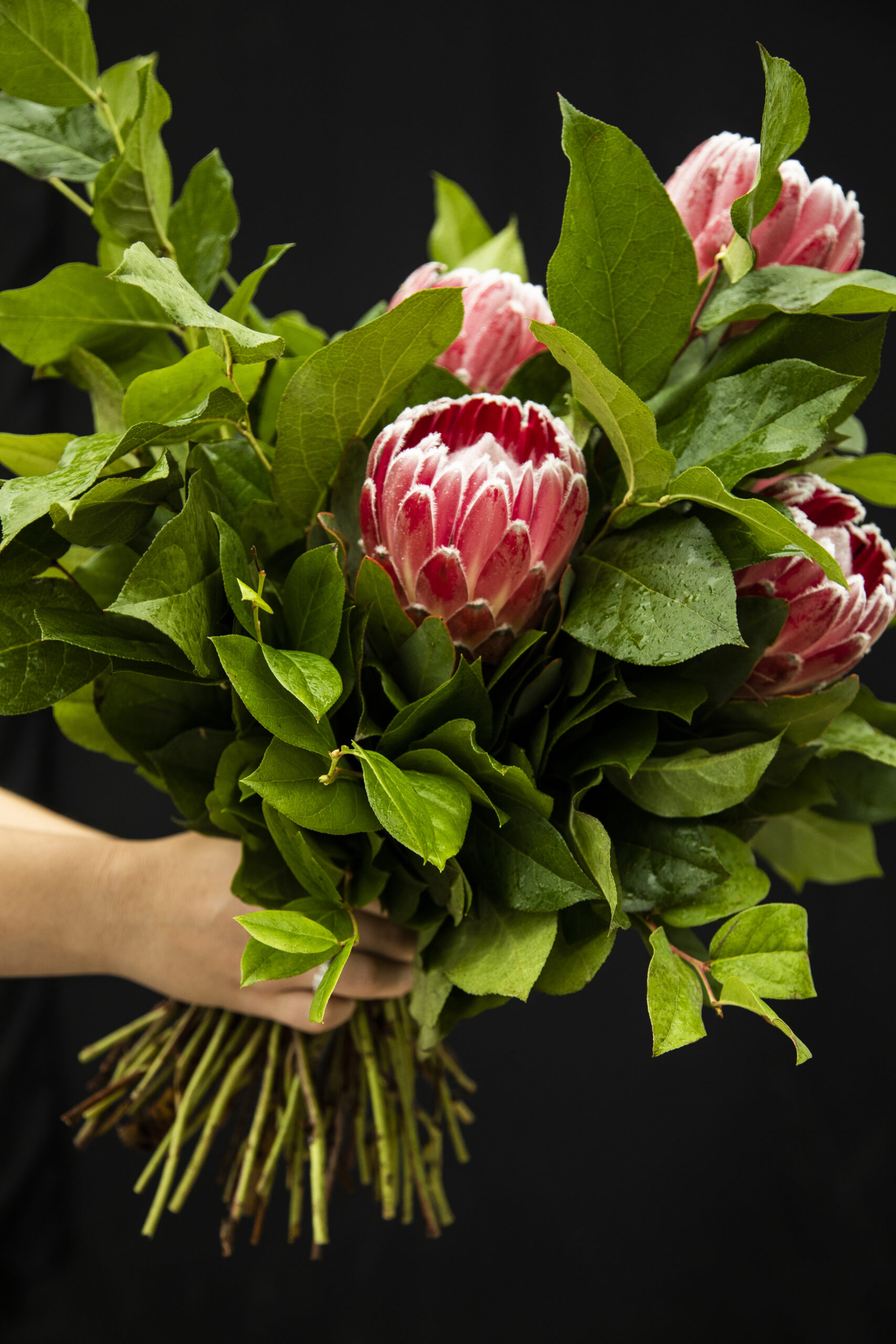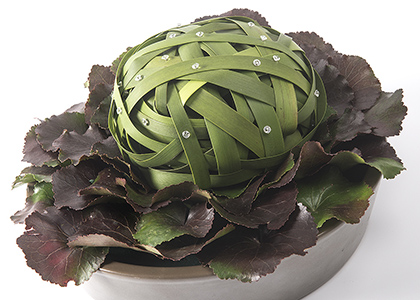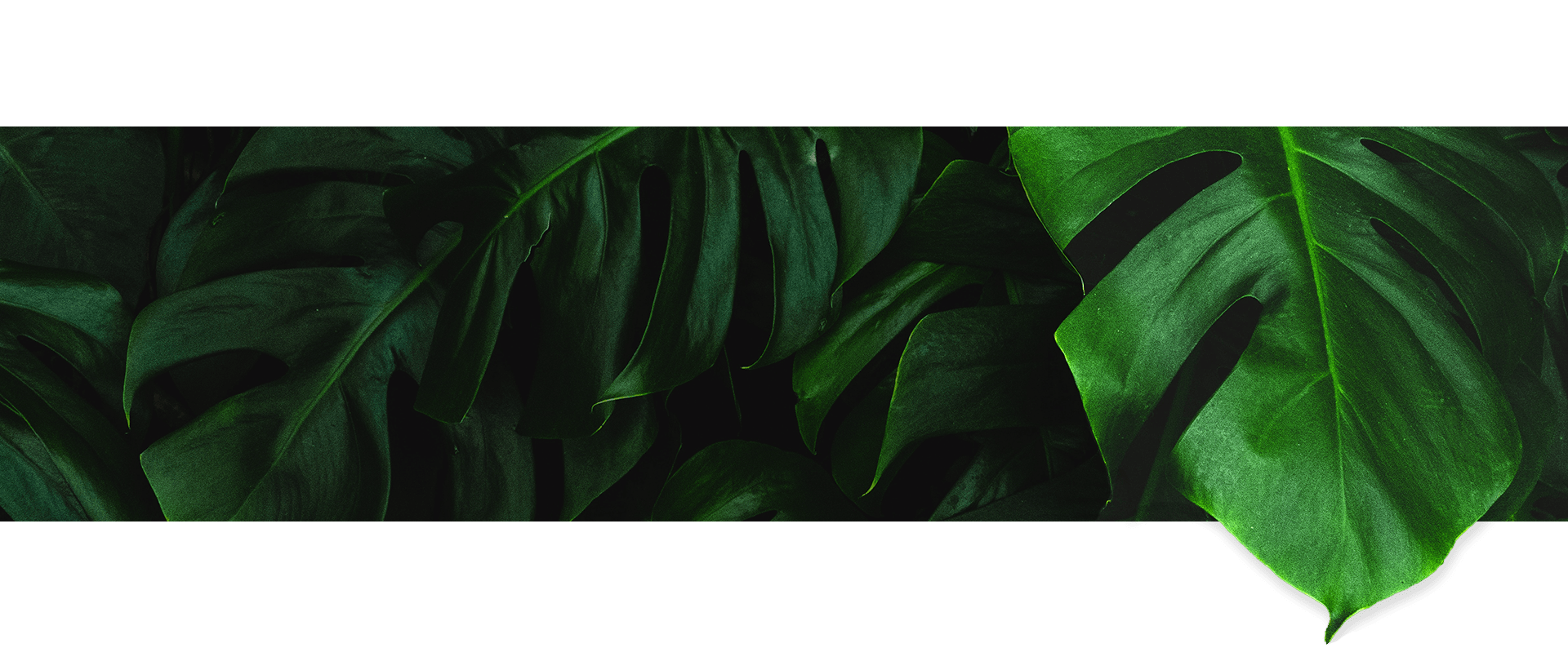OrcaGreen
Worldwide a synonym for cut greenery
OrcaGreen has been Adomex’s trusted green label for many years. The OrcaGreen brand is known and loved by green professionals around the world who appreciate and value quality and reliability. OrcaGreen high-quality cut greenery is used by florists and designers around the world in bouquets, arrangements and other floral creations.
It all started with Salal
Adomex introduced its Orca brand in 2003 when it began offering a ‘new’ product – Salal. Salal grows wild in (and is harvested from) the extensive forests in Washington State in the Northwest corner of the contiguous United States. Over the years OrcaGreen has developed into a much sought after and appealing brand offering a wide and varied range of both wild cut and cultivated cut greenery sourced from all over the world. Today’s OrcaGreen is a total private label popular with wholesalers (both importers and exporters) and florists and designers. The OrcaGreen range is only available from Adomex.
High quality and reliable availability
Adomex has selected its global network of cut greenery growers and suppliers very carefully and built up warm, long-lasting relationships with them. Only selected suppliers may supply the Orca brand. The result is virtually all-year-round availability of high-quality products. Today the box with a breaching orca can be seen everywhere – especially near flower professionals who opt for certainty when it comes to the quality of the green component of their bouquets or arrangements.
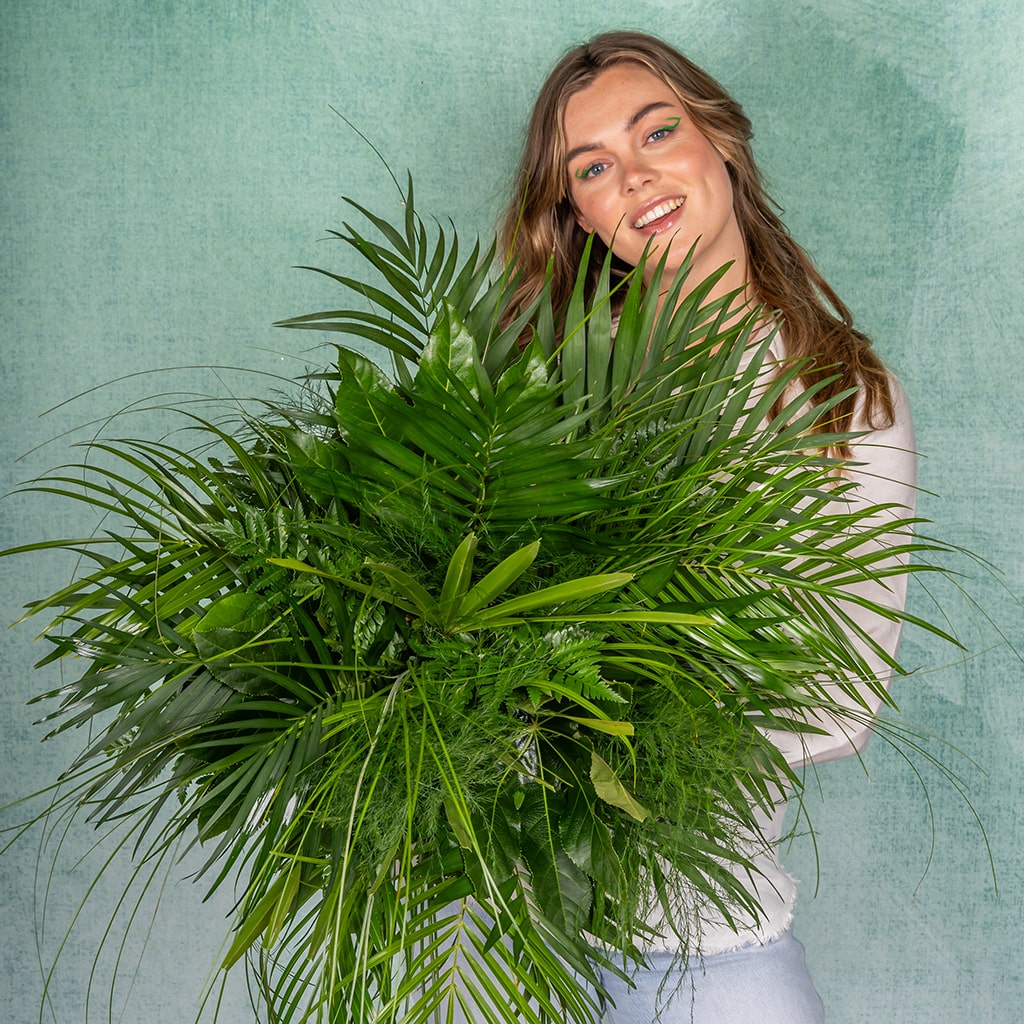
Orca Green has become a widely recognized brand
with wholesalers and florists over the years
Aralia
Exotic and elegant Aralia
Discover the beauty of Aralia. This cut greenery with its characteristic eight-lobed leaves adds a unique elegance to every floral arrangement. Aralia, or Fatsia japonica, owes its name to a rich history that goes back to Japan (‘fatsi’ means ‘eight’ in old Japanese). Because the leaf shape is reminiscent of a hand, in the Netherlands Aralia is also called Vingerplant (Finger Plant).
Aralia was originally grown in Japan and then later also in many other countries. Adomex imports all the Aralia for OrcaGreen from Costa Rica and Guatemala where the beautiful, exotically-shaped leaves are grown under shade cloths (saran), so they retain their lively green colour. Because the plants keep on growing our suppliers replace them every five years. This enables us to always guarantee the finest quality. After harvesting the leaves are washed and sorted by length, which varies from 20 to 80 centimetres.
Importing every week enables us to offer Aralia all year round. Their exotic, soft shape makes the leaves a very versatile addition to bouquets and corsages, including as a decorative round arrangement or as an edging or collar for bouquets.
Aspidistra
Versatile and super-supple Aspidistra
Aspidistra elatior derives its name from the ancient Greek word ‘aspidion’, which means ‘small shield’ and ‘elatior’ which means taller. It was brought to Europe from Japan and Taiwan in the 1820s and soon became a popular houseplant. Its common name, ‘Cast Iron Plant’, gives a clue as to why – Aspidistra plants are virtually indestructible: they survive almost all conditions and almost total neglect. Used as decorative greenery the plain, dark green, long, narrow leaves are equally tolerant. The leaves can be bent, folded, twisted, torn, stapled, glued and wired. This combination of sturdy and supple makes Aspidistra leaves ideal for creative use in bouquets and arrangements.
Although Adomex imports Aspidistra from Florida, Guatemala and Italy, all the OrcaGreen Aspidistra comes from Guatemala. This is because the Central American climate is particularly suitable for growing Aspidistra so a consistent quality can be achieved all year round. To protect the plants from fierce sunlight they are grown under a shade cloth – a ‘saran’. After cutting the leaves are dipped in water to rinse off the worst of the dirt. Any residual dust and mud is then brushed off by hand, which gives the leaves their glossy shine.
Aspidistra elatior leaves are available all year round in various lengths.
Beargrass
Robust and dynamic Beargrass
The olive-green, grass-like leaves of the perennial Xerophyllum tenax, better known as Beargrass, grow to around 75 centimetres long. This versatile decorative foliage came originally from the United States, where it is also known as Soap Grass, Quip-quip and Indian Basket Grass.
This fire-resistant greenery thrives in open woodlands and meadows right down the western side of North America from British Columbia to California at heights varying from sea level to 2,100 meters. Very often the plants are found growing under Alpine Larch and White Bark Pine trees. Our suppliers receive the harvested Beargrass from the pickers in large bales. They then clean it and tie it into smaller bunches. OrcaGreen Beargrass is available all year round.
The long, thin, blade-like Beargrass leaves are available in various packagings and dyed in many colours. This mobile foliage adds a dynamic, airy note to every bouquet and is easily bent and formed into all kinds of arrangements – from heart shapes to fan designs. It really has become an indispensable decorative greenery for creative floristry professionals all round the world.
Cat Palm
Tropical and ornamental Cat Palm
The Cat Palm, or Chamaedorea cataractarum, is a decorative small palm tree with long arching fronds. It came originally from Central America and Mexico where it grew in humid forests often alongside streams and waterfalls. This gave it its common name of Cat(aract) Palm or Cascade Palm. In the wild the trees can reach a height of 1.8 meters. A characteristic of the Cat Palm is the lack of a trunk – the fronds grow out of the ground as clumps of green stems. The long, cascading fronds are glossy green and pinnate in structure.
Adomex sources its Cat Palm from its supplier in Costa Rica where the plants are grown under shade cloths (saran) to protect them from the fierce sunlight. The Cat Palm fronds are harvested carefully in the field and taken to the processing plant where they are inspected for quality and cut to size. Adomex supplies Cat Palm in various lengths ranging from 50 to 100 centimetres.
Majestic Cat Palm leaves give a lush and luxurious look to every floral arrangement and add a tropical tint to every environment.
Chico & Teepee
Refined and pliable Chico and Teepee
Chico, or Chamaedorea elegans, is native to the rain forests of Mexico and Guatemala and is also known as the Palma Camedor (Parlour Palm), Mexican Dwarf Palm or Mountain Palm. In the wild the plants form a dense bush with several offshoots. Chico, like the related Teepee (Chamaedorea tepejilote) loves the humid tropical climate of Central America where they grow as a low under-storey in the bright, but indirect light under trees and taller shrubs.
Adomex imports most of its Chico and Teepee from Mexico. The indigenous people of La Huasteca (Chico) and Veracruz (Teepee) pick the wild palm fronds manually and with care and take the harvest to our exporter, who has been our permanent partner for over 25 years. The picking and processing provide employment in the remote areas and are an important source of income for local families. At the farm the Chico-leaves are sorted into three sizes: Chico (12 inch), Chico Doro and Chico Jumbo. The cut greenery is packed in bunches in the well-known OrcaGreen boxes ready for sending to Europe.
OrcaGreen Chico and Teepee are available all year round. Their pliable leaves are often used to edge arrangements and add an airy elegance and a refined, fragile atmosphere to bouquets.
Cocos Leaf
Lush and flexible Cocos Leaf
In Europe the shape of the dark green Cocos leaves is thought to resemble the tail of a fish. Hence its common name of Fishtail Palm. However, other people don’t see a fish tail they see rabbit’s ears and Cocos is called Rabbit Ears, while in Mexico the name Palma Xate is common. Whatever its local name, Chamaedorea ernesti-augustii grows in warm, sheltered and damp areas in dense, wet forests. The small palm trees with fused leaf segments is happiest in the tropical rain forests of South Mexico and North Guatemala en and in the wild can reach a height of around 1.8 to 2 metres. The male and female flowers of the Chamaedorea grow on separate trees.
Our Cocos leaves come from trees growing wild in the lush forests in the Mexican States of Tabasco and Chiapas. They are harvested by indigenous families and form an important source of income for the local community. On arrival in the processing plant of our partner, with whom Adomex has been doing business successfully for over 40 years, the leaves are washed, checked carefully for quality and sorted by leaf length. The characteristic Cocos Palm leaves are then packed in rolls and boxes ready for shipment. This decorative greenery stays fresh for a long time, so the quality when delivered to flower wholesalers all over the world is guaranteed.
Cocos leaves are available from Adomex all-year-round. The leaf lengths vary from mini (35 centimetres) to super (55 to 65 centimetres), which makes Cocos Leaf perfect for use in a wide variety of floral arrangements. The flexible leaves are easy to fold and to roll up to create an extravagant ‘feather headdress’. They can also be used to create a very simple, but very elegant, collar round a bouquet.
Coral Fern
Coral Fern with a unique wild woodland look
Coral Fern (Gleichenia polypodioides) is an elegant cut greenery that grows on the floor of the coniferous forests along the Southern Cape coast of South Africa. This unique fern with bare, tough stems flourishes in this rocky landscape with a high rainfall and often forms dense, impenetrable thickets.
All our Coral Fern is harvested from the wild. Throughout their growth the plants receive no fertilizer and are not sprayed. The only human intervention is the harvesting. The pickers have to look carefully to find the best quality stems. The selected stems of Coral Fern are picked by hand and, before leaving the forest, are tied into bundles. To be able to be sold every leaf must comply with stringent colour, shape, size and hardening criteria.
A length of 45 centimetres and all year round availability make Coral Fern ideal for flower arrangements and decorative pieces. The fragile, repetitive leaves look like tiny trees, which makes it easy to create arrangements with a woodland atmosphere. The leaves have a long shelf life and dry naturally so retain their shape. Whether the leaves are then dyed and/or sprayed with snow or are used in their natural form Coral Fern is always an eye-catcher.
Cordyline (Black Tie & Green Tie)
Soft and strong Cordyline
Adomex offers Cordyline fruticosa leaves in a number of varieties and colours. Under the OrcaGreen laber there are two varieties available: Green Tie and Black Tie. The long, pointed, elegant leaves of these tropical plants are reminiscent of a gentleman’s tie, hence the common name ‘tie’. Cordyline Green Tie has deep green leaves and Cordyline Black Tie has dark red, almost black, leaves. The two colours can be used separately, but when combined they give every arrangement extra contrast, depth and liveliness.
Adomex imports both Cordyline fruticosa varieties from its long-term partner in Costa Rica in lengths varying from 60 to 80 centimetres. Our supplier has an MPS-GAP certificate for international trade and works unceasingly on innovation and improving the production processes. After washing, sorting, cutting, bundling and packing the leaves are transported to the Netherlands by sea container.
OrcaGreen Cordyline Green Tie and Cordyline Black Tie are available all year round. The tropical leaves are soft yet strong and stand neatly upright. They also have a long ‘shelf life’ and look fresh for a long time. Cordyline leaves are an easy way to give bouquets and arrangements an exotic tint. This has made them a favourite of florists, floral designers and flower wholesalers around the world.
Eucalyptus
Fragrant and fast-growing Eucalyptus
The wonderfully fragrant Eucalyptus is native to Australia, where you find it in nature as a medium-sized tree or shrub. The variety Eucalyptic cinerea, also called Argyle apple or silver dollar tree, is a fast grower, which makes it particularly suitable for producing cut foliage. For this reason, it is now grown as a shrub in countries such as Italy, Portugal and South Africa. Growers simply cut the mature branches from the shrubs. At the end of each season, they cut the shrubs back to about one meter in height, after which the branches sprout again.
Adomex’s Eucalyptus cinerea comes from the southern Tuscan region of Grosseto. Here we deliberately work with one specific grower, so that we can control the entire production process: from product care and cutting to wrapping. As a customer, you can therefore always be sure of Orca quality Eucalyptus. Our variety Eucalyptus cinerea Long Orca has a length of 70 centimeters and a weight of about 300 grams per bunch. This cut green is available year-round, provided we can guarantee Orca quality. In the months of April through August, the availability of Eucalyptus cinerea sometimes decreases slightly as a result.
With its subtle, fresh menthol scent and somewhat whimsical appearance, Eucalyptus cinerea is an ideal cut green for flower arrangements and bouquets. The silver-gray colored round leaves have a delicate waxy coating, which makes them stand out beautifully against the flowers, fillers and other cut foliage present. Thus, they provide a luxurious, playful and natural effect in any floral creation.
Galax
Charming, heart-shaped Galax
Galax, or Galax urceolata, is a charming decorative type of greenery that is often referred to as Wandflower, Wandplant or Beetleweed. Galax plants are evergreen, so winter-hardy. The leaves are rosette shaped with a serrated edge. They are dark green with a matt-gloss turning to reddish-brown during the winter and especially around Christmas. The stem length is generally 5 to 10 centimetres long, but can sometimes be up to 15 centimetres.
The decorative plant grows in the USA in the shady Appalachian Mountains forests that form the border between North and South Carolina. The small town of Burnsville is the epicentre of the Galax industry. OrcaGreen’s Galax is harvested with care in the wild by experienced pickers. The leaves are delivered in large sacks to our supplier, who has been a permanent Adomex partner for over 15 years. They are then sorted into two sizes: regular (2 to 3 inches) and super (4+ inches). The leaves are not harvested between mid-April and mid-June to give new leaves enough time to grow.
Galax is available all year round. The leathery, heart-shaped leaves with short stems are ideal for small arrangements and corsages. The shape of the leaves adds a calming element. Florists and floral designers use a combination of dark green and reddish-brown Galax leaves to create stunning arrangements.
Leatherleaf Fern
Tough and timeless Leatherleaf Fern
The Leatherleaf Fern, Arachniodes adiantiformis, is a frequently used decorative greenery with strong, leathery, green fronds. Leatherleaf Ferns grow wild all over the world, but these versatile plants do best in a subtropical environment and in particular in cool, shady places, such as swampy ground and the area around caves and waterfalls. In these conditions Leatherleaf Fern plants reproduce rapidly and form colonies that spread over the ground.
Although Adomex imports Leatherleaf Fern from Guatemala, Costa Rica, Mexico, El Salvador and Florida (USA), all the OrcaGreen Leatherleaf Fern comes from selected growers in Guatemala and El Salvador. The plants are grown under black shade cloth (saran) to protect them from the sun. When fully grown the fronts are cut carefully and sorted by size. One grower sorts in the processing shed, another does it immediately in the field and then quickly puts the bunches into a cold room or refrigerator. Adomex transports the fronds in boxes both by sea (containers) and by airfreight. Leatherleaf Fern can also be vacuum packed to extend its shelf life.
OrcaGreen Leatherleaf Fern is available all year round. The available sizes vary from small to large, so purchasers can select the perfect size for their customers. This powerful decorative greenery has a long shelf life and florists around the world have been using it for many years as a basis component of arrangements and an edging for bouquets. Whether combined with roses for a classic look or with calla lilies for a refreshing twist, this timeless top-greenery adds natural beauty to every floral creation.
Lilygrass
Lush and trendy Lilygrass
Lilygrass, or in Latin Liriope, is a beautiful, lush ornamental grass that grows happily in the full sun, part shade or full shade. The bright green leaves are long, narrow and arching and in the summer and autumn the plants carry spikes of tiny purple flowers. Lilygrass is easy to propagate by dividing the plants in the early spring.
Adomex’s range includes both the all-over bright green Liriope muscari and the variegated Liriope variegata with its green and white lengthwise striped leaves. Both varieties grow to a height of 20 – 35 cm to 60 cm. The leaves we import from the Poás region in Costa Rica actually achieve a length of 70 to 80 cm. The leaves of both Lilygrass varieties are available from Adomex/OrcaGreen all year round.
Lilygrass is a frequently-used decorative greenery that, thanks to its calm appearance, combines very well with all kinds of flowers and other greenery. The sleek, glossy leaves enhance contemporary bouquets and trendy floral designs. Incorporating leaves of different lengths is a quick way to add a playful element. The grass-like stems are also easy to bend, which makes Lilygrass an ideal addition to bouquets and flower arrangements.
Palm
Large and spear shaped Palm
Serenoa repens, also known as the Saw palmetto or in the Netherlands Zegepalm, is a member of the Arecaceae-family. It grows in the sandy soil along the Atlantic Ocean and Gulf of Mexico coasts of the sub-tropical south-eastern United States. The Palms have sturdy stems and strong, spear-shaped leaves measuring from 55 to 90 centimetres. The leaves are arranged in a fan shape at the tip of the stem, which is why they are knows as ‘fan palms’.
Palms are known for their compact growth and multiple stems, which means the individual plants take up very little space. Most of the leaves are green with a silvery tinge. Adomex imports the decorative fronds from Florida in the United States. The leaves are carefully harvested from the palms that grow as ground cover in forests containing mainly pine and oak trees. The Palm leaves, in bunches of 10 stems, are packed in boxes and then shipped to the Netherlands in sea containers.
Our beautiful Fan Palm leaves are available all year round. The large, flexible stems are ideal for, and are guaranteed to be attention-getters in, lush arrangements and large designs.
Roebelenii
Pliable and moving Roebelenii
The much-loved ornamental Phoenix roebelenii, often called the Pygmy Date Palm, originally came from Southeast Asia. The narrow, slow-growing trees can reach a height of two to three metres and have fan-shaped fronds measuring from 50 to 120 centimetres.
To acquire its Roebelenii Adomex works with a supplier in Heredia, Costa Rica, that has been an Adomex partner for over 25 years. This company has been awarded important certifications, such as MPS-ABC, MPS-GAP and GLOBAL GRASP, and is very committed to achieving environmental, social and economic sustainability. Towards this end the company ‘employs’ over 700 sheep to walk around the nursery clearing up the fallen Roebelenii leaves and weeds and, at the same time fertilising the plants. Harvesting is followed by hydration, washing, sorting, cutting, bundling and packing into boxes ready to go into sea containers for the journey to the Netherlands.
Roebelenii with a length of 50, 60 and 80 centimetres is available all year round. Longer sizes, such as 100 and 120 centimetres are available in limited quantities. Phoenix roebelenii is a popular cut foliage for decorative applications. The very strong yet pliable leaves add movement to bouquets, which makes this decorative greenery a popular choice.
Salal
Wild and decorative Salal
Salal, commonly known as Lemon Leaf, Shallon (Gaultheria shallon) or in the Netherlands Appeltjesblad (Apple Leaf), can be recognised by its egg-shaped leaves with serrated edges. This very popular decorative greenery grows along the west coast of the United States and is harvested in the northwest States of Oregon and Washington. One special feature of Salal is that in some areas the leaves are a glossy dark green and in other areas they are a lighter green.
This beautiful cut greenery grows wild in the extensive forests from where it is picked by hand with care and restraint to ensure enough younger shoots are left to grow for the future. After harvesting the Salal is processed in packing sheds ready for transportation. Although Salal is available all-year-round the harvesting season begins around the second week in July. At that time the leaves are still not hard enough to withstand a long period in transit so they are flown to the Netherlands. Later in the season when the Salal has hardened it is packed in containers and taken by train from Vancouver to Montreal where it is loaded onto ships for international transportation. Only after the first night frost is the Salal hard enough to withstand the long sea journey through the Panama Canal to the Netherlands.
Salal is available all-year-round in three sizes: Salal Mini, Salal Tip and Salal Long. Its beautiful dark green colour, sturdy twigs and outstanding decorative characteristics make Salal a highly sought after by florists and flower/floristry wholesalers around the world.
Typha
Fresh and flexible Typha
Adomex supplies Typha from South Africa. These versatile ornamental grasses with their long narrow leaves offer unlimited creative scope for florists and floral designers around the world.
The long, narrow, fresh green leaves of Aristea confusa are available all-year-round in lengths of 70 and 90 centimetres. The name Aristea, which means ‘point’, refers to the sharp tip of the sword-shaped leaves.
Both sorts of Typha are extremely flexible and easy to shape into loops, plaits and other creative arrangements. This versatility makes the leaves a favourite of florists and designers.








